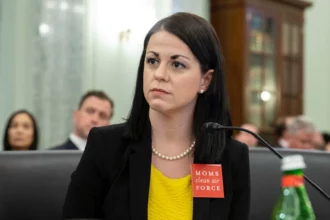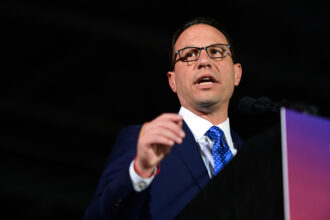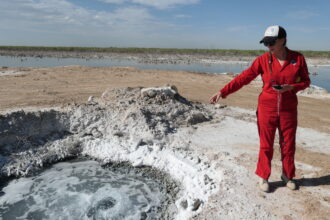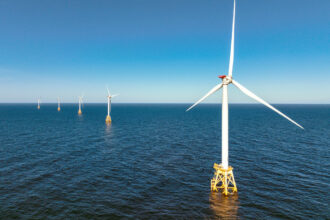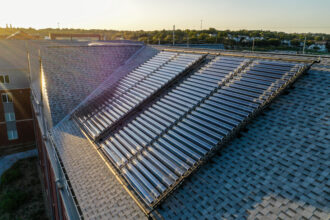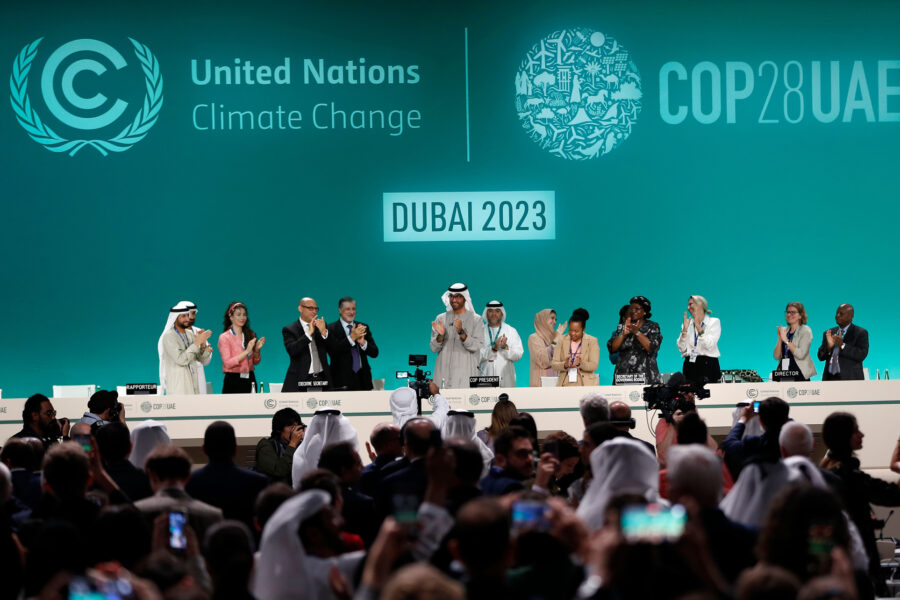On the evening of May 17, 1970, the 19th car of a freight train derailed in the Pennsylvania village of Cromby, a small town nestled along a horseshoe curve in the Schuylkill River about 30 miles from Philadelphia.
The car was carrying thousands of gallons of vinyl chloride, a highly flammable gas that is used to make polyvinyl chloride, or PVC, a plastic used to make pipes and flooring and known for its durability. En route to a nearby Pennsylvania plastics company, the train’s four cars containing the volatile chemical had originated at a plant in Freeport, Texas, 1,600 miles away.
Twenty families in Cromby were evacuated from their homes, and two police officers and a volunteer who was helping to evacuate people were taken to the hospital after being exposed to the toxic fumes.
To avoid a catastrophic explosion, firefighters sprayed water on the leaking car for 24 hours, emptying its contents into the Schuylkill even as some of the gas escaped into the air. The town’s municipal water treatment plant had to be shut down. “If somebody would have been careless with a match,” the local chief of police said, “all hell would have broken loose.”
Fifty years later, vinyl chloride has become infamous for its involvement in another train derailment, in East Palestine, Ohio, just over the Pennsylvania border. In February, officials released more than a million pounds of vinyl chloride into the environment in a controlled vent and burn, after five cars carrying 115,580 gallons of the hazardous chemical derailed. Two thousand residents were evacuated, and some have since experienced health issues they blame on the vinyl chloride burn.
East Palestine and Cromby are not unique: they’re just two examples in a long parade of vinyl chloride rail accidents that have struck communities across the United States without warning for decades, in Arkansas, Michigan, Louisiana, Illinois, Texas, Kentucky, Mississippi, and Paulsboro, New Jersey, on a track that the East Palestine train would have followed had it continued across Pennsylvania from Ohio, and which involved one of the same companies, OxyVinyls.
The story of the vinyl chloride on the East Palestine train–where it came from, how it was made, where it was going, and what kinds of products it would have eventually become–is a window into America’s vast plastics-making infrastructure, a system that stretches from gas fields in Appalachia to railyards in the Midwest to Gulf Coast petrochemical hubs to factories in the densely populated Northeast, encompassing thousands of miles of rail lines and pipelines as well as gas wells, storage facilities and plants. Because the ethane needed to make vinyl chloride is a byproduct of natural gas, it’s also an illustration of the side effects of the 21st-century fracking boom.
Fueled by abundant shale gas, the sprawling networks that made both the East Palestine disaster and the incident in Cromby possible are growing. “Plastic production is increasing not because consumers want more plastic,” said Judith Enck, the president of Beyond Plastics, an advocacy group working to end plastic pollution. “It’s because there’s a glut of fracked gas.”
The Appalachian Petrochemical Renaissance
When the gas industry and its champions talk about fracking, especially in politically contentious places like Pennsylvania, they tend to bring up its necessity as a source for essential heating and fuel. “Pennsylvania-produced natural gas essential to national security,” read the headline on an American Petroleum Institute press release in 2022. But in a world attempting to decarbonize its energy supply, plastics manufacturing has become increasingly important to companies eager to continue to profit from natural gas extraction.
“It’s all very much connected to natural gas. It’s one of the reasons why PVC is so cheap to manufacture in the United States, because of the fracking explosion that we’ve seen over the last 20 or so years in places like Pennsylvania,” said Mike Schade, the director of the Mind the Store program at Toxic-Free Future, a nonprofit focused on combating chemical pollution. A 2021 Beyond Plastics report on plastics and climate change reported that the plastics industry “consumes more than 1.5 billion tons of fracked gases annually.”
“We’ve seen the industry essentially have to invent new uses for gas, and that’s happening now,” said Eric de Place, an expert consultant on energy policy and fossil fuels. Whether it’s fertilizer, “blue” hydrogen or plastic, de Place said, “they’re just scrambling after whatever those new markets might be in order to find some justification to keep drilling and making money.”
Overall, the total amount of oil and gas used for the production of plastics is around 15-20 percent, depending on what and how you count, said Sean O’Leary, senior researcher in energy and petrochemicals at the Ohio River Valley Institute, noting that more natural gas goes into power generation for plastics manufacturing than is used as feedstock.
“Still, because demand for power from natural gas and oil is stagnating globally while demand for plastics has continued to rise, natural gas producers see plastics as an important market for the future,” he said.
The production of vinyl chloride and PVC starts with natural gas. Natural gas is processed and then fractionated into individual components like butane, propane and ethane, which is what is used to make vinyl chloride. “Over the last few years, the region has invested in a lot of fractionation capacity, and that’s been largely to serve the petrochemical industry,” de Place said. “They can usually get more money from the gas liquids than they can from the gas.”
Ethane from Appalachia is shipped to the Gulf Coast via the Appalachia to Texas Express pipeline, or ATEX, which opened in 2014, and runs from Washington County, Pennsylvania, the most fracked county in the state, to Mont Belvieu, Texas. A 2015 pipeline failure resulted in a leak of 30,565 barrels of liquid ethane in West Virginia; no one was injured, but the resulting fire burned five acres of forest. In 2019, Houston-based Enterprise Products Partners, ATEX’s owner, announced plans to expand the 1,200-mile pipeline.
Pipelines like ATEX feed into storage facilities like the one in Mont Belvieu, outside Houston, where natural gas liquids are stored in huge underground cavities. From there, ethane is transported to cracker plants, which use high heat to break apart the bonds of ethane molecules and “crack” them into ethylene, a feedstock for plastic-making. Vinyl chloride is made by combining ethylene and chlorine.
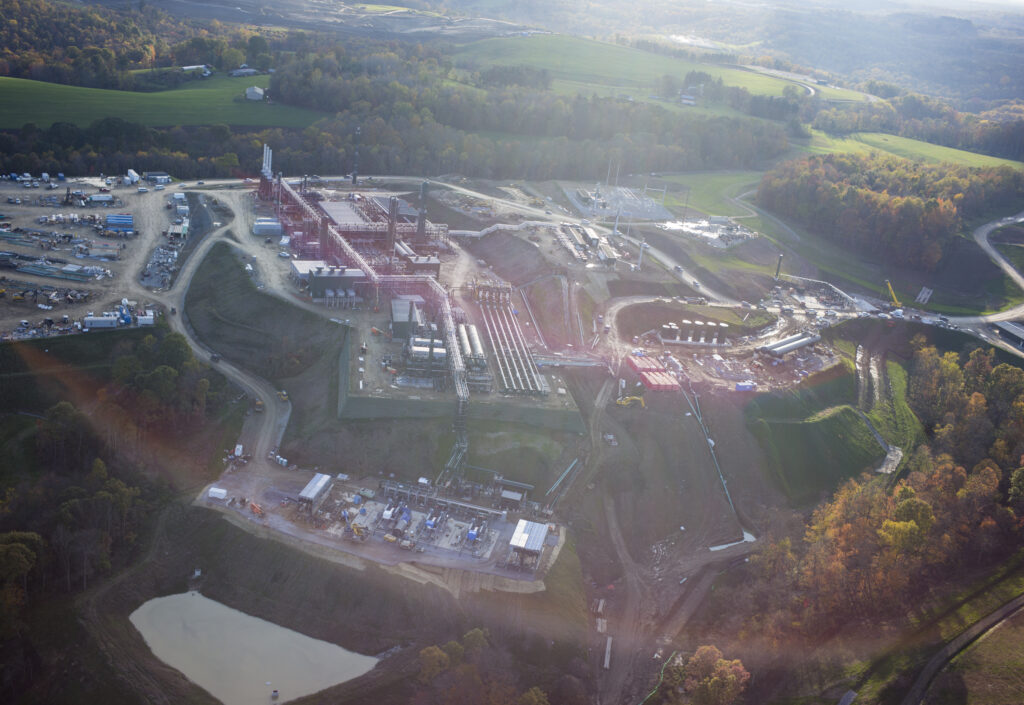
At Mont Belvieu, “it all gets commingled and redistributed throughout the Gulf Coast to chemical plastics plants,” said Jim Vallette, a researcher, and president of Material Research, who has investigated toxic waste, plastics manufacturing and the East Palestine accident. Using the Mariner East pipeline across Pennsylvania, petrochemical companies are also shipping Appalachian ethane overseas on giant carriers that leave Pennsylvania via a terminal in Marcus Hook, outside Philadelphia.
When ATEX came online, the petrochemical company Westlake’s Calvert City, Kentucky ethylene cracker plant switched from a propane feedstock to ethane sourced from the Appalachian Marcellus Shale formation. At Calvert City, Westlake uses the resulting ethylene to make PVC. In 2014, Westlake touted its location in Kentucky as “the only fully integrated vinyls complex located outside of the Gulf Coast,” giving it a shipping advantage for certain key markets, such as the Midwest, the Northeast and Canada.
In 2020, a U.S. Department of Energy report called “The Appalachian Energy and Petrochemical Renaissance,” estimated that the Appalachian region was producing 250,000 barrels per day of ethane, 20,000 of which went to the Westlake facility. The largest amount, 125,000 barrels per day, was sent to the Gulf Coast via the ATEX pipeline. Of the six major natural gas liquids pipelines operating in Appalachia, four carry ethane. The report identified Appalachia’s “competitive advantage” in petrochemical manufacturing because of its natural gas resources and close proximity to market demand. Vinyl chloride and PVC production was included as a potential “opportunity” for growth in the region.
The U.S. production capacity of ethylene has increased by 50 percent since 2015, and the industry has opened 12 new ethylene cracker plants between 2017 and 2022, with more proposed or under construction. These plants consume massive amounts of natural gas: Shell’s Monaca, Pennsylvania ethylene cracker, 20 miles from East Palestine and opened in 2022, is fed by more than 1,000 active fracking wells and 98 miles of pipeline. Cracker plants require power plants to run, and Beyond Plastics concluded in 2021 that together these plants emit 70 million tons of carbon dioxide per year.
From the cracker plant, ethylene is moved to factories like OxyVinyls’ vinyl chloride facility in La Porte, Texas, which is where three of the cars carrying vinyl chloride on the East Palestine train came from. Vallette identified the LyondellBasell ethylene cracker, also in La Porte, as a probable source of ethylene for the Oxy factory. Since 2017, six new ethylene cracker plants have opened in Texas alone, including a new ethylene cracker built by Occidental in 2017 in Ingleside that can produce 1.2 billion pounds of ethylene annually.
OxyVinyls, a subsidiary of Occidental Petroleum Company, is the largest manufacturer of vinyl chloride in the U.S., and Occidental Chemical, the parent company of OxyVinyls, is the largest producer of vinyl chloride in the world. At sites like La Porte, ethylene is combined with chlorine, made from brine, to create ethylene dichloride and then vinyl chloride, which is polymerized into PVC resin. “PVC has become the last refuge of chlorine as other products have left the market,” Vallette said, like chlorinated bleach and chlorinated pesticides. In 2021, the La Porte facility reported releasing 7,347 pounds of vinyl chloride into the air, and in 2022, a chemical fire broke out at the site.
Echoes of the Past
From La Porte, Texas, the vinyl chloride on the train that would end up in East Palestine traveled to St. Louis and then through Illinois, Indiana and Ohio via Toledo and Cleveland. The presence of vinyl chloride on a derailed train can turn an accident into a life-threatening emergency, necessitating the evacuation of hundreds or thousands of nearby residents, exposing first responders to a carcinogenic chemical and requiring painstaking cleanup. “It’s just insane to ship vinyl chloride halfway across the country to turn it into resin,” Vallette said. “It makes no logical sense, and it doesn’t seem to make economic sense to me either.”
“Because vinyl chloride is so hazardous, when you’re transporting it through communities, you basically have a toxic time bomb on the rails,” said Charlie Cray, a senior research specialist at Greenpeace who has been studying vinyl chloride and PVC since the 1990s. “If it leaks, you can’t control what direction it goes in,” he said. “Communities are not prepared. First responders may not be prepared.”
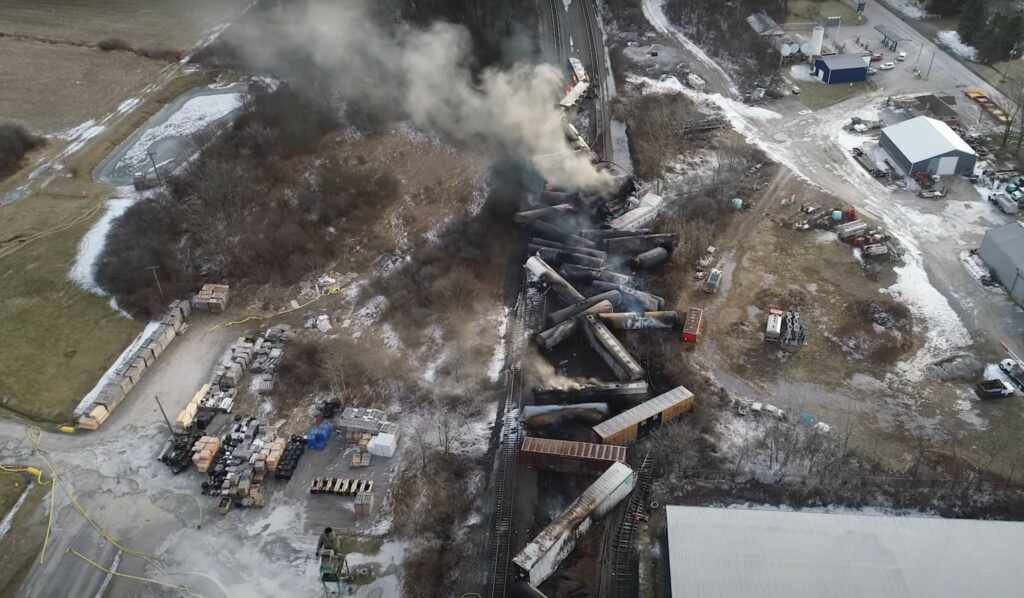
According to Occidental’s own safety manual, from 2020, vinyl chloride is a “known human cancer agent,” which may “produce symptoms of dizziness, nausea, loss of balance, drowsiness, and respiratory irritation,” and “causes damage to the nervous system, musculoskeletal system, lymphatic system, and respiratory system through prolonged or repeated exposure.” It is also “suspected of causing genetic defects” and “is a potential endocrine disruptor.” Vinyl chloride “may mass explode in fire and may explode if heated.” The manual warns first responders that vinyl chloride is a “severe fire hazard,” and to wear personal protective equipment, isolate the area and keep leaks away from water supplies and sewers.
When vinyl chloride burns, it releases dioxins, Cray said, highly toxic chemicals that can cause reproductive, developmental and immune problems and accumulate in food chains. Dioxins were released during the East Palestine accident burn, but they are also created during the vinyl chloride manufacturing and waste disposal process, exposing people living nearby.
“There’s really no safe level of exposure to them,” said Jess Conard, a resident of East Palestine who has since become an environmental advocate and the Appalachia director for Beyond Plastics. “I was very ill that first week, like lay-down, can’t-move my-body ill,” she said. “Since the derailment, my husband has had migraines more frequently. My four-year-old was diagnosed with asthma. My other son had an unknown eye irritant for almost two weeks.”
Conard said most residents’ acute symptoms, including nosebleeds, rashes, headache and fatigue, are gone now, but fears about the long-term effects of exposure linger, and some people are still displaced from their homes. “Every day I wake up and ask myself that question: Is it safe to be here?” Conard said.
Enck said that there are chemical car train derailments weekly in the United States—but unless they are dramatic, they typically don’t get reported in the media.
Records from the National Transportation Safety Board and newspaper archives indicate at least nine major rail accidents involving vinyl chloride, other than the one in East Palestine: a 1982 derailment in Louisiana, when 1.2 million pounds of vinyl chloride spilled, and 2,700 people were displaced for two weeks; a 1978 accident in Arkansas, when 1,700 fled a vinyl chloride explosion on a track behind a petroleum plant; the 2012 Paulsboro spill; and an incident in 2003 in Illinois, when the residents of the town of Tamaroa were evacuated following a vinyl chloride freight train accident.
There were also accidents in Mississippi in 1969, Michigan in 1966, affecting 4,000, and Kentucky in 1980, when 6,500 were evacuated from Fort Knox and the town of Muldraugh, and two tanks of vinyl chloride were burned. In 1971, a freight train passing through Houston derailed, and vinyl chloride from the train “escaped and ignited.” One firefighter died and 50 people were injured. In 1983, there was another vinyl chloride accident in Louisiana, this time in Baton Rouge, when a tank car leaked and a “large billowing fire ensued,” injuring two people seriously.
A newspaper article describing the scene in Livingston, Louisiana in 1982 wrote that “explosions of tank cars continued” the next day after the derailment, and “when dawn came, a faint black haze colored the sky as far as 10 miles away.” NTSB records do not include smaller incidents like the one in Cromby, Pennsylvania.
“We live just over two miles from the site, but the railroad tracks are right out back,” Conard said. Not long after the vinyl chloride burn, she saw trains going by again, and she still sees them now.
From East Palestine, Occidental’s vinyl chloride cars would have traveled across Pennsylvania on Norfolk Southern tracks, through Pittsburgh, Harrisburg, the state’s rural heartland, and the Philadelphia suburbs, to a railyard in South Philadelphia, and to OxyVinyls’ PVC resin factory in Pedricktown, New Jersey, about 30 miles south of Philadelphia and just across the river from Wilmington, Delaware.
“Plants like the Pedricktown plant are vestiges from a different time, a different kind of more domestic economy,” Vallette said, before the plastics industry became the global behemoth that it is today. “These trains that are running along the tracks are kind of like echoes of the past.”
A PVC Ping Pong Match
In the 1970s, the vinyl industry faced scrutiny after it was revealed that four workers at a PVC plant in Louisville, Kentucky had died of a rare form of cancer called angiosarcoma of the liver. “Usually accounting for fewer than two dozen deaths in the United States in any given year, the occurrence of four deaths from angiosarcoma of the liver in a population of a few hundred workers at one plastics plant was truly alarming,” the authors of the 2002 book Deceit and Denial explained. Later studies of workers in PVC and vinyl chloride plants found that the risk of developing this “extremely rare” type of cancer “increased strongly with duration of exposure to vinyl chloride.” The studies also found links to hepatocellular carcinoma.
In 1981, B.F. Goodrich, the company that owned the Pedricktown facility before Occidental, was ordered to pay $391,291 to the family of a local man who had died of angiosarcoma of the liver. The man, John Grasso, lived with his wife and six children less than two miles from the plant, and his lawyer argued that his illness was the result of toxic emissions from the plant.
The industry says now that controls put in place in the 1970s have “virtually eliminated” these cancers in workers, and that communities living near vinyl manufacturing sites are “protected from harmful exposure levels.” But the Pedricktown PVC plant reportedly released 3,929 pounds of vinyl chloride in 2021, and an investigation by Vallette’s company Material Research found evidence of 12 chemical accidents or leaks at PVC and vinyl chloride sites in the U.S. since 2010.
Despite the dangers of manufacturing and transporting vinyl chloride and years of environmentalist calls to ban it, PVC production in the U.S. has increased from 2.4 billion pounds annually in the 1970s to 15.4 billion pounds today. In 2018, Shin-Etsu, the world’s largest producer of PVC, announced plans to open a $1.43 billion PVC plant in Plaquemine, Louisiana in 2021, increasing the company’s production capacity by 10 percent, and more expansions are planned. (In the 1980s, an entire Louisiana town was relocated after pollution from PVC and vinyl chloride was found in the air, soil and water near a Georgia Pacific plant in Plaquemine.)
“The U.S. has been competing with China as the cheapest source in the world for PVC,” Vallette said. For Shin-Etsu, a Japanese company, Louisiana’s access to cheap shale gas makes it attractive for producing PVC. In 2022, Vallette worked on a report called “Built on Repression” about China’s use of forced labor in Xinjiang, the Uyghur region, to make PVC. He said that it’s possible that environmental and human rights revelations about PVC manufacturing in China could push more PVC production to the United States. If that happens, Appalachia could become “the new Xinjiang,” he said.
This story is funded by readers like you.
Our nonprofit newsroom provides award-winning climate coverage free of charge and advertising. We rely on donations from readers like you to keep going. Please donate now to support our work.
Donate NowPVC is the third most-used plastic in the world, according to the Vinyl Institute, a trade association for the vinyl industry. Called “the infrastructure plastic,” building and construction materials are the most common uses for PVC, accounting for 70 percent. You can find PVC on the shelves of your local Home Depot or Lowes, and likely in your home, in the form of piping, fencing, roofing, decking, siding and flooring. There is probably PVC in your wallet right now: it’s the material that credit, debit and gift cards are most often made of, according to a 2022 report from Beyond Plastics. OxyVinyls’ vinyl handbook lists other typical applications for their products: bottles, ceiling tiles, furniture, blood bags, shoes, toys, packaging, windows, home playgrounds, signs, sports equipment, electric cables, surgical gloves and insulation.
During manufacturing, additives are added to many of these products to add flexibility and stability. Phthalates, a common additive in PVC, can “leach, migrate, or gas out…into air, dust, water, soils, sediments, and food” and are known as endocrine disruptors that are “detrimental to human health,” according to a 2021 study. The study goes on: “Chronic exposure to phthalates will adversely influence the endocrine system and functioning of multiple organs, which has negative long-term impacts on the success of pregnancy, child growth and development, and reproductive systems in both young children and adolescents.” Some kinds of phthalates are banned for use in children’s toys.
Like vinyl chloride, PVC is toxic when it’s burned. “When PVC is disposed of, or when it burns in accidental fires, it can also pose serious risks to first responders,” Schade said. OxyVinyls’ 2015 safety manual for PVC resin warns firefighters to avoid inhalation when dealing with a PVC fire.
Although vinyl chloride and PVC production affects communities across the country, the places that bear the heaviest burden tend to be low-income communities with predominantly non-white residents. According to a report from Toxic-Free Future, 373,262 Americans live within three miles of a facility connected in some way to manufacturing or disposing of vinyl chloride or PVC, and 63 percent are people of color. “This is a major issue of environmental justice,” Schade said.
Places like the Gulf Coast’s “Cancer Alley” and western Pennsylvania, where petrochemical facilities are clustered, are not the only communities at risk, especially when the entire system is considered from extraction to disposal. In Pennsylvania alone, 1.5 million people live within a half mile of an active gas or oil well, compressor, or processing station, and 3.9 million Pennsylvanians live within a half mile of an active rail line.
Waste from the Pedricktown plant is shipped back to an Occidental PVC plant in Deer Park, Texas, as was the waste from the East Palestine disaster. “You have this ping pong match between Pennsylvania and Texas,” de Place said, where gas in Appalachia is drilled and fractionated, sent south by pipeline to be made into vinyl chloride, only to be shipped north again, through Pennsylvania, for manufacturing as PVC resin in New Jersey. The toxic waste moving back to Texas extends the volley and its hazards. “You don’t have to be near the well or the petrochemical facility to be affected by it,” de Place said. “Because it might be traveling past you anyway.”
“The Material for Life”
This year, Beyond Plastics and other environmental groups launched a petition to ban vinyl chloride, gathering 27,000 signatures that were delivered to the EPA at a meeting in July, and the Biden administration is considering a formal review of the chemical. Alongside the petition, Beyond Plastics and other environmental groups like the Healthy Building Network are working to raise awareness of PVC alternatives like recycled copper and stainless steel pipes and linoleum flooring.
The Vinyl Institute says that it “welcomes” the review, “which will further assure that production of vinyl chloride and PVC products are safe. Manufacturers of vinyl chloride adhere to some of the most stringent safety and environmental regulations in the chemical industry.” The group touts strict industry protections for workers who are most likely to be exposed to high levels of vinyl chloride.
Vinyl chloride has been banned for aerosol use in the U.S. since 1974, and the EPA designates it as a human carcinogen, but Enck said that the EPA has not moved to ban vinyl chloride for other uses before now because of the power of groups like the Vinyl Institute, which uses the slogan “The Material for Life.” “It’s pure politics,” she said.
“It will be a major fight,” Cray said. “This is an existential threat to the industry.” In July, the Vinyl Insitute published a statement labeling the new petition a “publicity stunt” that ignores “decades of credible science” showing vinyl chloride is “safely and responsibly manufactured.” The group accused Beyond Plastics of “using the tragic events of East Palestine to advance deceptive and disproven claims about our industry that only serve to mislead the public.”
Vallette thought it was unlikely that the EPA would act to ban vinyl chloride; he has seen the power of the Vinyl Institute to influence policy before. But he didn’t rule it out entirely. “That would be a remarkable thing,” he said. “Maybe that can happen. Things can change. This is an antiquated plastic.” He thought it more likely that the rail transportation of vinyl chloride could be banned. “That might be a starting point,” he said.
In 2011, the old rail line through Cromby was converted into a branch of the Schuylkill River Trail, a greenway that runs west from Philadelphia. Today, the spot where the derailment occurred is a quiet trailhead where people come to walk and bike. Hawks circle overhead, and the water sparkles through the trees, the only sounds the rustle of dead leaves and the hum of distant traffic. There is no sign that vinyl chloride once spilled here, stirring panic. But, just as in East Palestine, freight trains and their chemical cargo have not disappeared from Cromby–there’s now a Norfolk Southern track on the other side of the river.







